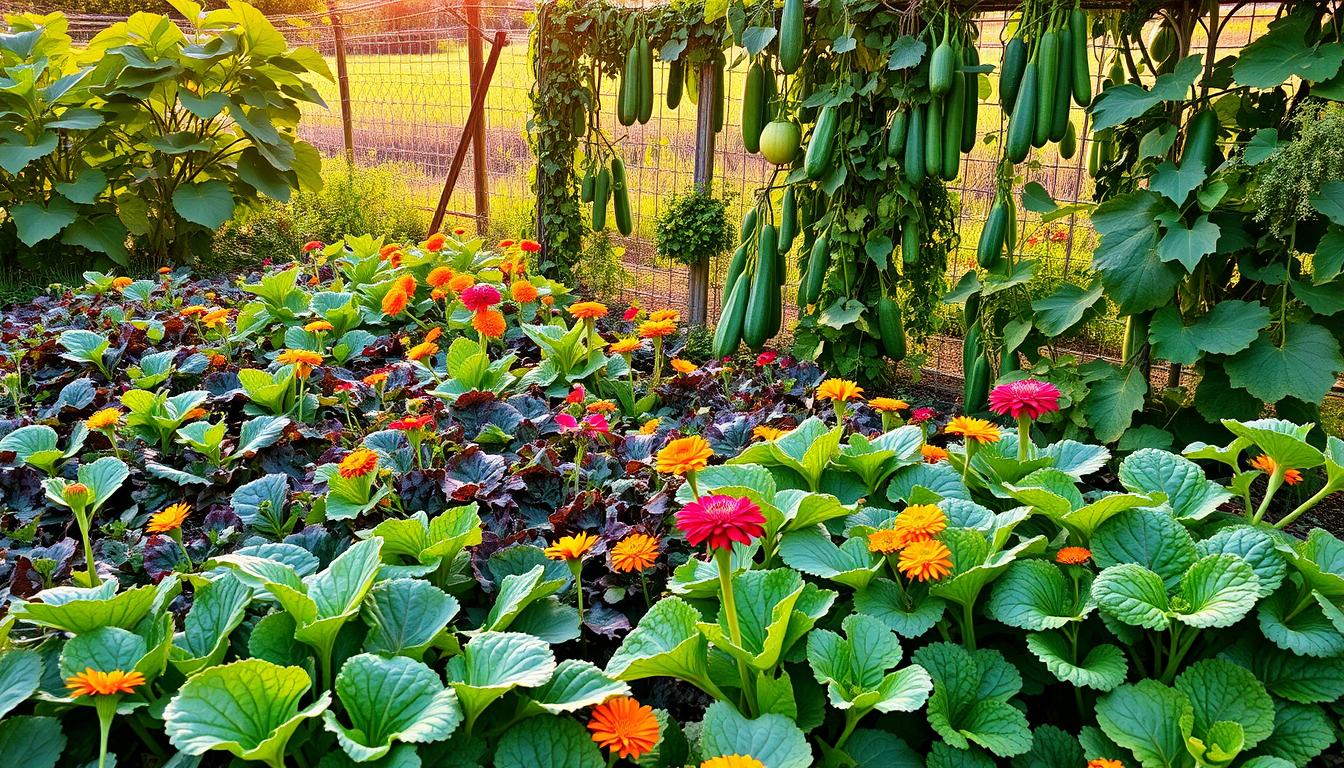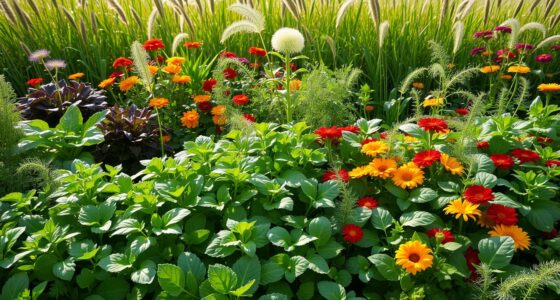Picture yourself on a warm summer day, harvesting juicy watermelons from your garden. The satisfaction of biting into a sweet, sun-ripened slice is an experience like no other. But did you know that what to plant with watermelon can elevate your gardening experience even further? By choosing the best companion plants for watermelon, you can create a thriving ecosystem that nurtures growth and enhances flavor. Companion plants for watermelon not only repel harmful pests, but they can also attract beneficial insects, improve soil health, and provide necessary shade. Let’s explore the top picks that will help your watermelon garden flourish!
Key Takeaways
- Companion planting enhances growth and health of watermelons.
- Choosing the right plants can repel pests while attracting beneficial insects.
- Healthy soil is supported by selecting appropriate companion plants.
- Shade from certain plants can protect delicate watermelon vines.
- Strategically combining plants promotes a thriving garden ecosystem.
Why Companion Planting Matters for Watermelons
Companion planting significantly impacts the success of watermelon cultivation. Understanding the benefits of companion planting reveals how it optimizes growing conditions for this beloved fruit. By strategically pairing watermelon with the right plants, you can create a thriving garden ecosystem.
Benefits of Companion Planting
One major advantage of companion planting is the ability to enhance soil fertility. When you decide what to plant with watermelon, consider including legumes, which fix nitrogen in the soil. This nutrient boost promotes healthier watermelon plants and can lead to higher yields. Additionally, some companion plants may help create a microclimate, reducing heat stress during scorching summer days.
How it Enhances Growth
Choosing the right companion plants can accelerate the growth of watermelons. For example, crops like corn can provide natural support, while ground covers like clover can conserve moisture and suppress weeds. These strategies play a vital role in maximizing watermelon yields with companion planting, ensuring your plants receive the ideal conditions for robust growth.
Pest Control through Companion Plants
Another key aspect of companion planting involves natural pest management. Certain flowers and herbs can deter harmful insects that threaten your watermelon crop. For instance, planting marigolds nearby has been shown to repel aphids and other pests, providing an additional layer of protection. Utilizing companion planting not only enhances growth but also minimizes pest-related issues, making it a smart strategy for any gardener.
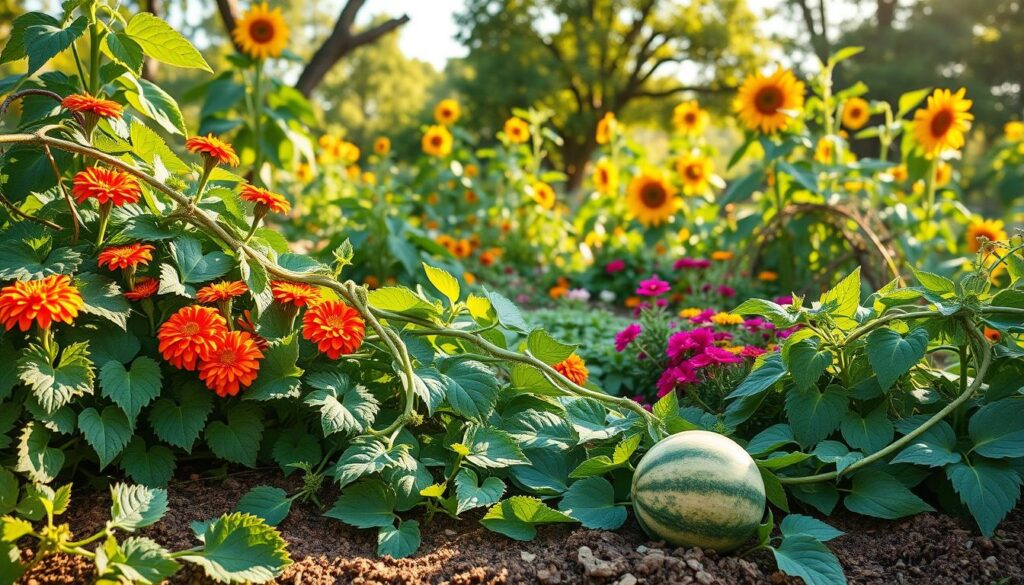
Best Companion Plants for Watermelons
When considering the best companion plants for watermelons, several options stand out for their unique benefits. Pairing watermelon with specific plants enhances growth, maintains soil health, and aids in pest control. By choosing these beneficial plants to grow with watermelon, you can create a thriving garden that supports both your watermelons and the larger ecosystem.
Basil: A Flavorful Companion
Basil serves as an excellent companion for watermelons due to its ability to repel various pests like aphids and mosquitoes. The strong aroma of basil can mask the scent of your watermelons, preventing these unwanted insects from being drawn to the fruit. Planting watermelon with other vegetables such as basil enhances your garden’s resilience while providing you with fresh herbs for your kitchen.
Marigolds: Pest Deterrents
Marigolds are well-known for their pest-repelling qualities. These vibrant flowers ward off harmful insects that might threaten your watermelon crop. In addition to pest control, marigolds attract beneficial pollinators, contributing further to a balanced ecosystem in your garden. Selecting marigolds as one of the best companion plants for watermelon allows you to enjoy bright colors while safeguarding your plants.
Radishes: Helping with Soil Health
Radishes are not only quick to mature but also serve a practical purpose in the garden. Their roots can help break up compacted soil, promoting better drainage and aeration for watermelon roots. Incorporating radishes alongside your watermelons provides a natural way to enhance soil health. Overall, planting watermelon with other vegetables like radishes ensures a productive growing environment while maximizing your space effectively.
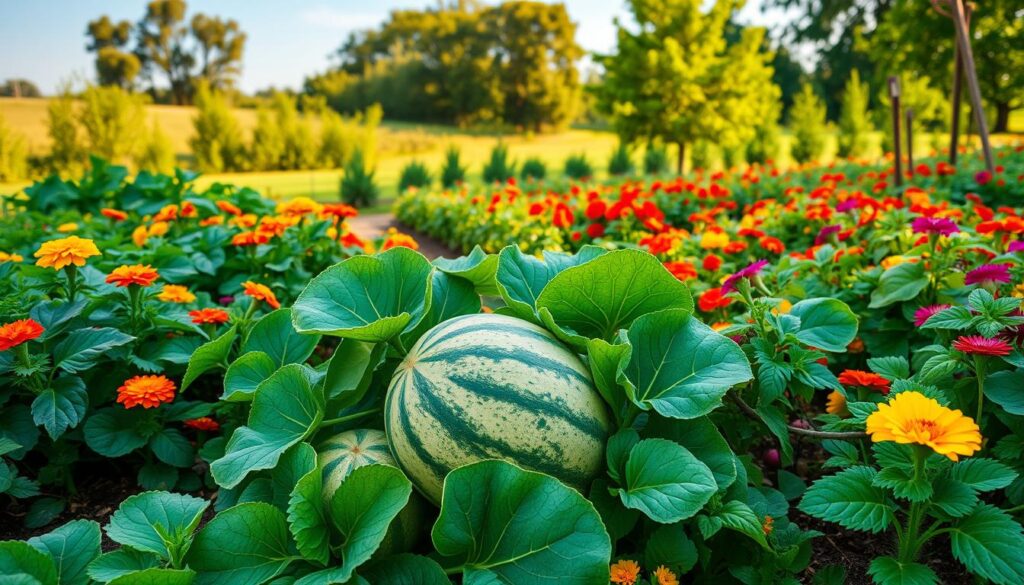
Herbs that Thrive with Watermelons
In the world of *vegetable garden companion planting*, selecting herbs that grow well with watermelon can enhance your overall garden health and productivity. Many herbs not only complement watermelons in flavor but also contribute to pest management and soil health. Here are three excellent options that you can incorporate into your garden.
Oregano: Aromatic and Beneficial
Oregano is a fantastic choice for those looking to boost their watermelon crop. This herb repels common pests like aphids and spider mites, helping to protect your watermelon plants. Furthermore, oregano promotes moisture retention in the soil, keeping your watermelon plots hydrated during dry spells.
Thyme: Low Maintenance and Helpful
For gardeners who prefer low-maintenance plants, thyme is an ideal herb to pair with watermelon. This hardy herb is drought-resistant and thrives with minimal care. Thyme attracts beneficial insects, such as bees and hoverflies, which can aid in pollination and contribute to a healthier garden ecosystem.
Cilantro: Enhancing Flavor and Diversity
Cilantro offers both flavor and diversity to your garden. As an herb that grows well with watermelon, cilantro not only enhances the taste of your dishes but also enriches the biodiversity of your vegetable garden. Adding cilantro can attract beneficial insects while providing a fresh herbal touch to your meals.

Vegetables to Pair with Watermelons
When planning your garden, it’s essential to consider which vegetables to grow with watermelon. Selecting the right companions can enhance growth, improve yield, and make your garden more efficient. Intercropping with watermelon introduces a synergy that benefits both plants. Let’s explore some ideal candidates for planting watermelon with other vegetables.
Corn: A Supportive Tall Crop
Corn serves as a natural trellis for watermelon vines. This tall crop offers shade, reducing heat stress on the watermelon, particularly during intense summer heat. Furthermore, the two plants create a microenvironment that fosters better growth and can lead to higher yields.
Cucumber: Sharing Space Efficiently
Cucumbers are another excellent choice when planting watermelon with other vegetables. Their sprawling nature beautifully complements watermelon, as they utilize available space without overcrowding. By intercropping with watermelon, you can enjoy both fruits without sacrificing garden space.
Squash: Mutual Growth Benefits
Squash provides ample foliage that not only creates a canopy, reducing soil evaporation but also suppresses weeds. This mutual growth benefit allows both watermelon and squash to thrive together. Incorporating squash in your garden enhances the overall health of your crops while keeping them compact and manageable.
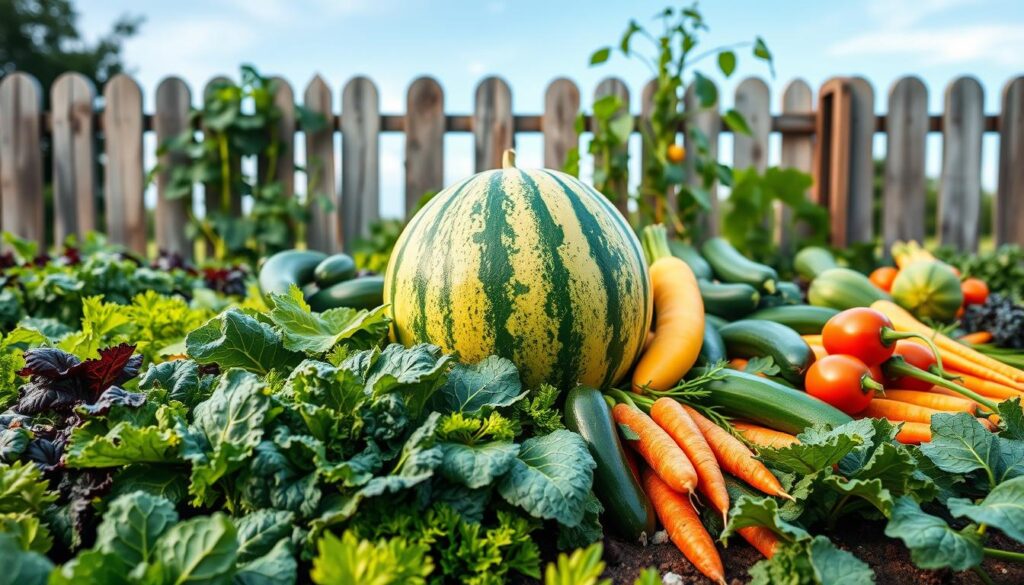
| Vegetable | Benefits | Growth Compatibility |
|---|---|---|
| Corn | Provides shade, reduces heat stress | Supports watermelon vines |
| Cucumber | Efficient use of space | Mineral sharing benefits |
| Squash | Suppresses weeds, retains moisture | Creates a micro-ecosystem |
Flower Options that Pair Well
Incorporating flower companion plants for watermelon into your garden can enhance both the aesthetics and health of your plants. Flowers play a vital role in attracting beneficial insects, providing support, and deterring pests, making them excellent companions for watermelons. Here are some top choices to consider.
Sunflowers: Attracting Pollinators
Sunflowers are not only striking in appearance but also serve a functional purpose in your garden. These tall beauties attract pollinators such as bees, which are crucial for the pollination of watermelons. Additionally, their height can provide shade and structure for other plants, creating a more balanced growing environment.
Zinnias: Brightening Your Garden
Zinnias bring a splash of color to any garden while attracting beneficial insects that help protect your plants. Their bright blooms can liven up the space, making your garden a cheerful sight. These are among the best plants that grow well with watermelon, as they enhance visual appeal while supporting biodiversity.
Nasturtiums: Edible and Protective
Nasturtiums are a unique addition to your garden as they are both edible and protective. These vibrant flowers can act as trap crops, luring pests away from your watermelon plants. They not only add a pop of color but can also be used in salads, making them a dual-purpose companion.

| Flower Type | Benefits | Compatibility with Watermelon |
|---|---|---|
| Sunflowers | Attracts pollinators, provides shade | High |
| Zinnias | Attracts beneficial insects | Moderate |
| Nasturtiums | Edible, deters pests | High |
Avoiding Pest Issues with Companion Plants
In the world of gardening, pest control through companion plants plays a vital role in maintaining the health of your watermelon crops. By cleverly pairing plants, you can create a natural defense system against pests. Certain companion plants are known for their ability to repel harmful insects while attracting beneficial species that assist in pollination and pest control.
How Companion Plants Ward Off Pests
Companion plants such as marigolds and garlic serve as formidable barriers against various pests. Marigolds produce compounds that deter aphids and beetles, reducing infestations significantly. Garlic, on the other hand, emits a strong odor that many insects find repelling. These strategies are key in avoiding pest issues with companion plants, allowing your watermelon plants to thrive.
Beneficial Insects to Attract
Encouraging beneficial insects like ladybugs and predatory wasps can enhance your garden’s health. These insects play an essential role in keeping pest populations in check. Planting flowers such as dill and fennel will attract these helpful creatures, ensuring a balanced environment for your watermelon plants and reinforcing pest control through companion plants.
Creating a Balanced Ecosystem
A balanced ecosystem is the heart of a thriving garden. By selecting the right annuals and perennials, you can create a habitat that supports various insects and promotes plant health. Techniques such as crop rotation and diverse planting strategies ensure that you maintain an ecological balance, further avoiding pest issues with companion plants. A harmonious garden not only protects your watermelons but also promotes biodiversity and enriches your gardening experience.
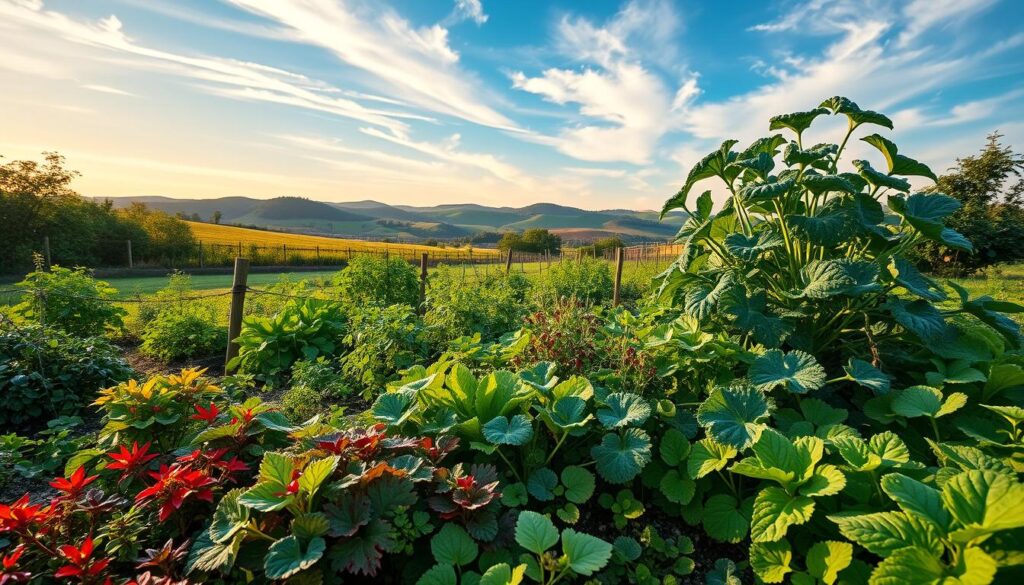
Soil and Nutrient Considerations
When it comes to growing healthy watermelons, understanding soil and nutrient dynamics plays a crucial role. You need to be aware of the nutrient requirements for watermelon to ensure that your plants thrive. Proper soil management not only benefits watermelon plants but also enhances overall garden productivity.
Nutrient Requirements for Watermelons
Watermelons flourish in nutrient-dense soil. They require ample levels of nitrogen, phosphorus, and potassium. Monitoring soil pH levels, ideally between 6.0 and 6.8, is also vital for optimal nutrient absorption. Regular soil tests can help you gauge nutrient needs and adjust your fertilization accordingly.
Enhancing Soil with Companion Plants
Incorporating companion plants into your garden can significantly contribute to soil health for watermelon plants. For instance, legumes such as beans and peas can fix nitrogen in the soil, enriching it naturally. This practice not only benefits your watermelons but also promotes biodiversity in your garden, creating a more resilient ecosystem.

Crop Rotation and Its Importance
Practicing crop rotation is essential for maintaining soil vitality. Rotating watermelon with plants that have different nutrient demands can prevent soil depletion and reduce the risk of pests and disease. This strategic approach keeps your garden healthy, ensuring that it continues to provide bountiful harvests year after year.
Seasonal Companion Planting Strategies
Effective timing in your planting strategies can significantly enhance your watermelon growth. Each season brings unique opportunities for seasonal companion planting for watermelon, allowing you to plant watermelon with other vegetables that complement its growth. Here are some recommendations for spring, summer, and fall planting to maximize your harvest.
Spring Planting Recommendations
In spring, begin with cool-season crops. Radishes can be sown early, helping to break up the soil while planting watermelon with other vegetables later in the season. Additional options for early planting include:
- Peas
- Spinach
- Kale
These crops benefit your garden ecosystem and prepare the soil for subsequent warm-season plants.
Summer Companion Planting Tips
As the temperatures rise, focus on warm-season crops that thrive alongside watermelon. Planting watermelon with other vegetables like cucumbers or corn can optimize space and provide shade. Ideal choices during summer include:
- Sunflowers – attracting pollinators
- Basil – enhancing flavor and growth
- Squash – beneficial for moisture retention
This combination not only promotes growth but also creates a vibrant garden that supports biodiversity.
Fall Season Combinations
In the fall, consider planting companion crops that will utilize the remaining growing season effectively. You might try:
- Garlic – planted after harvesting watermelon
- Turnips – ideal for late-season growth
- Cover crops like clover – replenishing soil nutrients
These combinations help in maximizing your garden’s potential while preparing it for a fruitful next season.
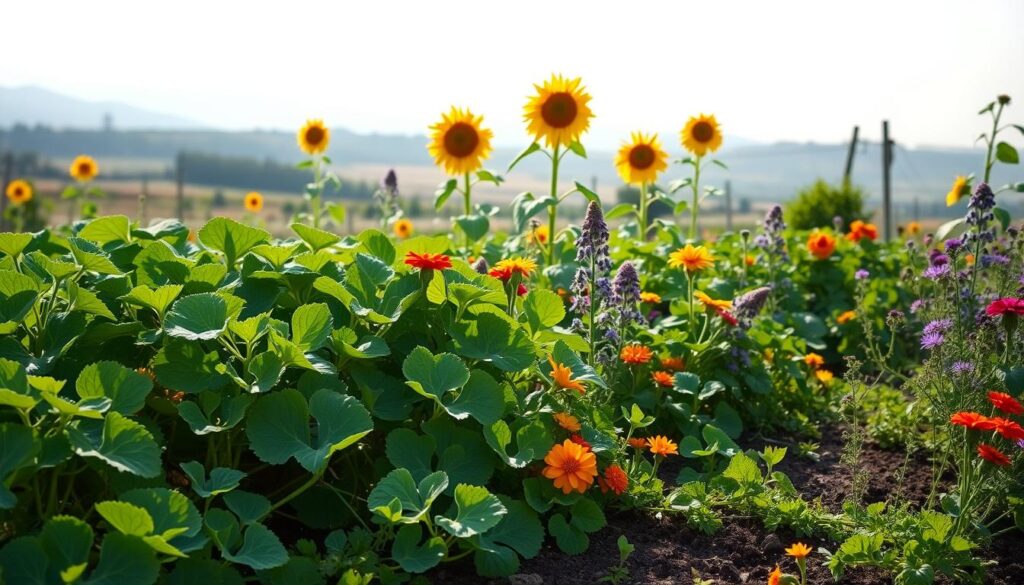
Watering Practices for Companion Plants
Successful gardening not only hinges on choosing the right plants but also on understanding the specific watering practices for watermelon plants. Consistent moisture is vital for the health of both watermelons and their companions. Knowing how to water effectively can lead to better growth and higher yields. It also helps prevent water-related stress that can impact both watermelons and what to plant with watermelon for maximum benefit.
Importance of Consistent Moisture
Watermelons thrive in consistently moist soil. Maintaining this balance encourages healthy root development and fruit production. For companion plants, the right moisture levels complement watermelon growth, enhancing your overall garden success. Inconsistent watering can lead to issues like blossom drop or poor quality fruits.
How to Water Effectively
To ensure you’re maximizing watermelon yields, consider the following tips for effective watering:
- Water deeply and infrequently to encourage root expansion.
- Use mulch to retain soil moisture and regulate temperature.
- Implement drip irrigation to deliver water directly to the roots.
- Monitor soil moisture levels regularly with a moisture meter or by hand.
Signs of Over or Under-Watering
Identifying the signs of over or under-watering can save your plants from stress. Look for yellowing leaves, wilting, or stunted growth as indicators. Ensuring the right conditions will keep your watermelon plants and their companions flourishing side by side.
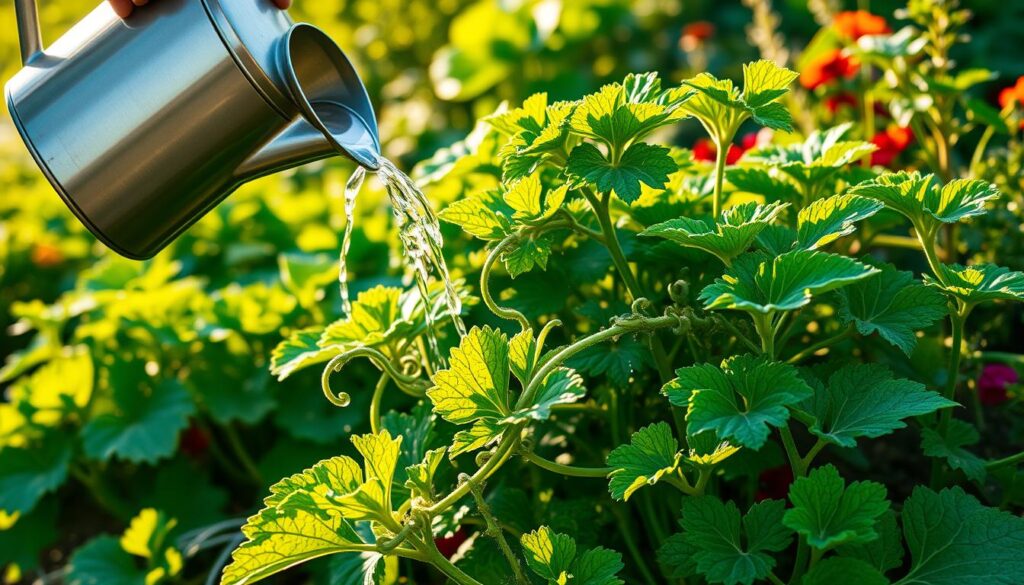
Organic Solutions for Pest Management
Finding effective methods for organic pest management for watermelon plants can lead to healthier crops and a more sustainable garden. Utilizing natural repellents and companion plants for pest control creates a nurturing environment that promotes biodiversity while safeguarding your watermelon plants.
Natural Repellents to Consider
Several natural repellents can help keep pests at bay without the risk of harmful chemicals. Here are some highly effective options:
- Garlic: Known for its strong scent, garlic acts as a natural deterrent for various pests.
- Neem Oil: Extracted from the seeds of the neem tree, it disrupts the life cycle of pests upon contact.
- Peppermint Oil: The strong aroma of peppermint is quite effective in repelling insects.
Companion Plants as Pest Barriers
Introducing companion plants for pest control can serve as an effective strategy in your garden. For watermelon plants, consider these companions:
| Companion Plant | Pest Control Benefit |
|---|---|
| Marigolds | Repel nematodes and aphids |
| Basil | Attracts beneficial insects while deterring flies and mosquitos |
| Nasturtiums | Act as a trap plant, luring pests away from your watermelons |
Attracting Beneficial Pollinators
Creating a garden that attracts beneficial pollinators is vital for maximizing watermelon yields. Incorporating flowers such as sunflowers and zinnias not only beautifies your space but also brings in bees and butterflies. These pollinators play a crucial role in the fertilization of your watermelon plants, leading to a bountiful harvest.

Harvesting Watermelons with Companion Plants
When it comes to harvesting watermelons, understanding the right timing can significantly impact the quality of your fruit. Knowing the signs of watermelon ripeness ensures that you pick your melons at their peak flavor. Additionally, applying effective harvesting techniques for watermelon will help you enjoy a bountiful yield.
Timing Your Harvest
The timing of your watermelon harvest is key. Most watermelons typically need about 70 to 90 days from planting to reach maturity. Observing the tendrils near the stem can give you an idea of the correct timing. When the tendril is brown and dry, your watermelon is nearing readiness for harvest.
Signs of Watermelon Ripeness
Incorporating practices such as listening for the right sound can further aid in determining ripeness. Gently thumping the watermelon should produce a deep, hollow sound if it’s ripe. Other signs of watermelon ripeness include changes in the color of the bottom spot, which should transition to a creamy yellow as it matures.
Maintaining Your Garden Post-Harvest
Post-harvest maintenance is important for your garden’s future success. After picking your watermelons, ensure to check on the companion plants that provided beneficial support. Removing any dead foliage and weeds can boost air circulation and nutrient availability in the soil for subsequent planting. Taking care of these elements will prepare the soil effectively for what to plant with watermelon next season.
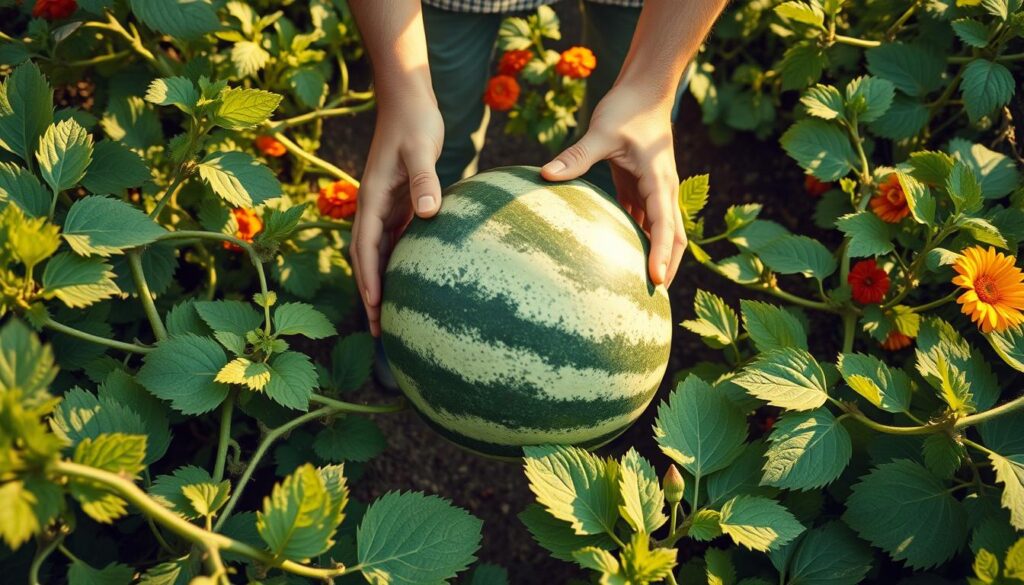
| Ripeness Indicators | Description |
|---|---|
| Tendril Color | Brown and dry indicates readiness. |
| Sound Test | Deep, hollow sound upon thumping. |
| Bottom Spot Color | Creamy yellow shows maturity. |
| Size and Shape | Full and symmetrical shape is ideal. |
Real-Life Success Stories
Exploring real-life success stories in companion planting reveals valuable insights about its impact on gardens. Home gardener experiences often highlight how combining plants can lead to remarkable growth and pest control. Many individuals and communities have successfully enhanced their watermelon cultivation through thoughtful companion planting strategies.
Home Gardener Experiences
Home gardeners share success stories that illustrate the practical benefits of pairing different plants. For example, one gardener found that planting basil alongside watermelons not only improved the flavor of the melons but also helped deter harmful insects. These positive outcomes encourage others to explore similar planting combinations in their own gardens.
Lessons Learned from Expert Growers
Expert growers frequently emphasize the importance of strategic planting. Learning from their experiences reveals that certain plant pairings can create a healthier growing environment. For instance, pairing marigolds with watermelons proved beneficial by reducing pest populations, showcasing the effectiveness of this technique.
Tips from Community Gardening Projects
Community gardening projects often share invaluable community gardening tips derived from shared experiences. Collaboration allows gardeners to learn from one another’s successes. Engaging in group gardening not only builds friendships but also encourages innovative methods, enriching the overall growing experience for everyone involved.
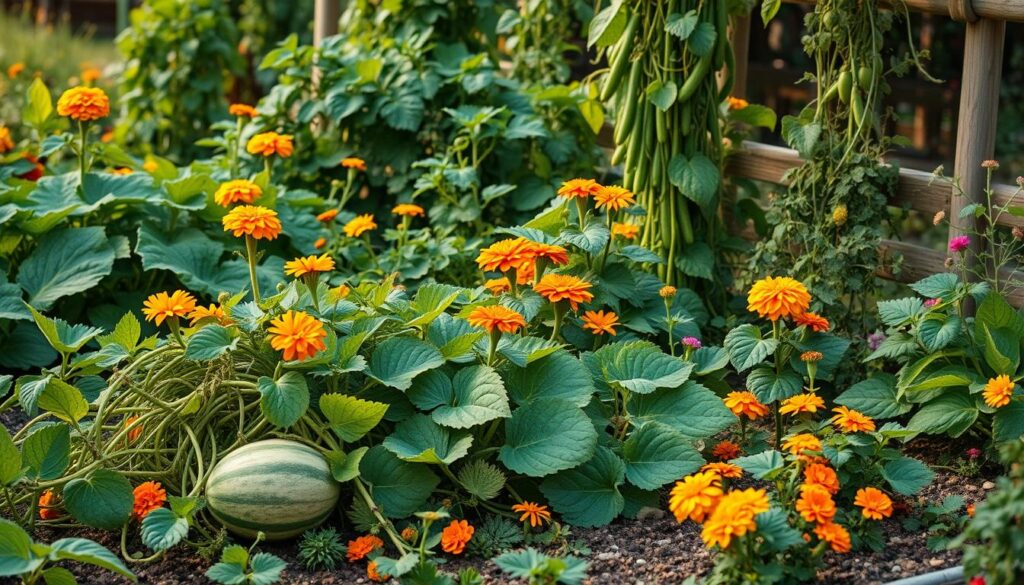
| Gardener Type | Success Story | Companion Plant |
|---|---|---|
| Home Gardener | Basil improved watermelon flavor and pest resistance. | Basil |
| Expert Grower | Marigolds reduced pest problems effectively. | Marigolds |
| Community Gardener | Collaborative planting inspired innovative techniques. | Various |
Troubleshooting Common Issues
When you encounter challenges in your garden, it’s essential to identify the root causes as quickly as possible. Troubleshooting garden issues such as yellowing leaves, pest infestations, and uneven growth patterns can greatly improve the health of your plants. Understanding how companion planting can influence these factors helps you make informed decisions about what to plant with watermelon.
Yellowing Leaves: What to Do
Yellowing leaves can indicate nutrient deficiencies, overwatering, or poor soil conditions. A quick assessment can help you determine the issue. Consider checking the soil’s nutrient levels. Adding compost or fish emulsion may enhance nutrient availability. Sometimes, adjusting your watering schedule can also address this issue. Engaging in companion planting with fast-growing legumes like peas will enrich the soil while providing a symbiotic relationship for your watermelons.
Pest Infestations: Quick Fixes
Spotting pests early can save your plants from major damage. Examine your plants regularly for signs of aphids or other insect problems. Utilizing companion plants such as marigolds may deter these invaders naturally. You may also consider spraying a homemade soap solution to eliminate minor pest populations effectively. Integrating natural pest control tactics with your planting strategy can significantly reduce the amount of intervention needed.
Uneven Growth Patterns: Solutions
Uneven growth can result from multiple factors such as inconsistent watering or competition for sunlight. Observe your plants closely. If taller plants overshadow watermelons, relocating them or pruning may help. In addition, ensuring even watering throughout your garden is vital. Utilizing mulch will help retain moisture and regulate soil temperature, contributing to more uniform growth. Experimenting with a variety of companion plants that can share space harmoniously can also lead to healthier overall growth.

The Role of Sunlight in Companion Planting
Sunlight plays a pivotal role in the growth of watermelons and their companion plants. Understanding the sunlight needs for watermelons helps ensure they develop healthily and achieve optimal yields. When planning your garden layout for companion planting, it’s essential to organize your plants based on their sun requirements, ensuring all receive adequate light without being overshadowed.
Sun Requirements for Watermelons
Watermelons thrive under full sunlight, requiring at least six to eight hours of direct light daily. This exposure not only promotes photosynthesis but also helps in ripening the fruit. Pay close attention to your watermelon plants, as insufficient sunlight can lead to smaller yields and poorly developed fruits.
Companion Plants and Sunlight Needs
Many companion plants share similar sunlight needs, which can benefit your watermelon production. For instance, herbs like basil and oregano love the sun and can thrive alongside watermelons. When selecting companions, consider those that can contribute to a healthy garden ecosystem, ensuring they won’t block the sun from reaching your watermelons.
Planning Your Garden Layout
A well-thought-out gardening layout for companion planting prioritizes sunlight accessibility. Taller plants, such as corn, should be placed to the north of your watermelon patch, preventing them from casting shadows. This strategic arrangement allows both the watermelons and their companions to bask in the sun, optimizing their growth potential.
| Plant | Sunlight Needs | Companionship Benefits |
|---|---|---|
| Watermelons | Full sun (6-8 hours) | Optimal fruit development |
| Basil | Full sun (6-8 hours) | Pest repellent |
| Corn | Full sun (6-8 hours) | Shade provider for other crops |
| Oregano | Full sun (6-8 hours) | Enhances soil quality |
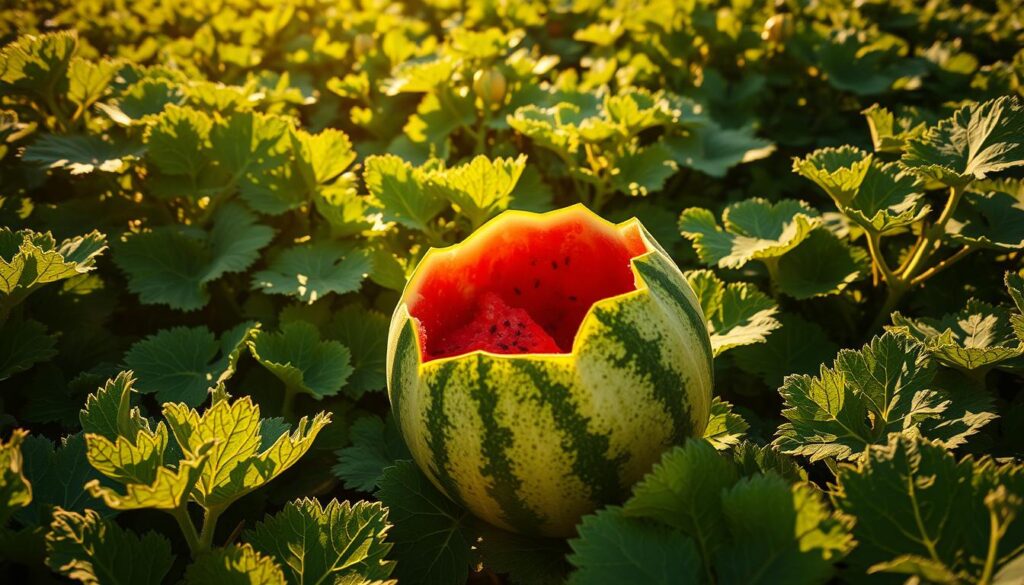
Future Gardening Trends
As you explore the evolving world of gardening, future gardening trends are steering towards innovative practices that prioritize sustainability. With an increasing focus on biodiversity, companion planting emerges as a crucial technique to enhance yields and create healthier ecosystems. Embracing these sustainable gardening practices not only contributes to environmental health but also facilitates community engagement and education.
Emerging Companion Planting Techniques
Emerging techniques in companion planting highlight the significance of planting species together that benefit each other. This helps improve pest management and soil health. By learning and applying these methods, you can cultivate a more resilient garden while contributing to future gardening trends that prioritize ecological balance.
Technology in Sustainable Gardening
Game-changing technology plays a pivotal role in today’s horticultural innovations. Smart gardening solutions, such as automated irrigation systems and soil sensors, enable gardeners to implement sustainable gardening practices efficiently. This technological advancement supports better growth and cultivates a connection to the land.
Community Involvement and Education
Community gardening education remains essential in fostering a sense of belonging while teaching individuals about sustainable practices. Being part of community gardening initiatives encourages you to share knowledge and resources, further promoting the adoption of future gardening trends. This collaboration not only enriches personal experiences but also strengthens community bonds.

Conclusion: Creating Your Ideal Watermelon Garden
In crafting the perfect watermelon garden, understanding the conclusion on companion planting becomes crucial. Implementing strategies that integrate beneficial plants alongside your watermelons can create a thriving environment. You’ll find that the benefits of companion plants extend beyond mere plant variety; they enhance growth, promote pest control, and improve overall health in your garden. Each carefully selected companion plays a role in enriching your gardening experience.
Encouraging a balanced garden ecosystem requires thoughtfulness in your choices. You’ll want to maximize the interactions among plants to promote healthy growth and commendable yields. In doing so, you not only enjoy an abundance of watermelons but also contribute positively to the surrounding environment, which can be immensely gratifying.
Your next steps in companion planting should include familiarizing yourself with the specific needs and benefits of potential companions. By actively engaging in this practice, you contribute to ideal plans for watermelon gardening that yield flavorful and plentiful harvests. Don’t hesitate to experiment and observe the effects, as every garden is unique and offers its own set of learning opportunities!
